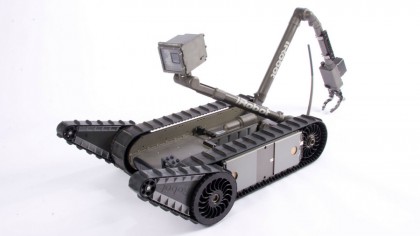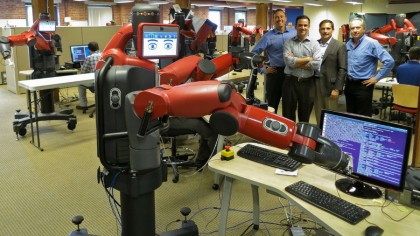Will robots like Honda's Asimo steal our jobs?
A third of jobs could be automated by 2035
Where do robots work?
In dirty, dull, dangerous places in industrial counties like the US, China, Japan and Korea, though countries like India, Thailand and Central/Eastern European nations have recently been adopting robotics, too.
Factories making everything from cars, planes and trains to TVs, cameras and most household appliances use robots to permit both dust-free assembly, and increased accuracy. Critical industries like consumer electronics, food, solar and wind power, and advanced battery manufacturing are all heavily robotised.

Robots are present elsewhere, too. Drones are robots, while tracking and surveillance robots like the Samsung SGR-1 claims to have no blind spots and can – in theory – identify and 'dispatch' an enemy soldier without human intervention. About 300 iRobot PackBot Tactical Mobile Robots remove unexploded bombs and mines from war zones and collect forensic evidence in Iraq and Afghanistan, and have worked in the tsunami-damaged Fukushima nuclear power plant in Japan. The technology comes from a prototype Martian rover named Rocky-7, a test bed for NASA's Mars rovers Spirit and Opportunity.
iRobot also has robot cleaners like the Roomba, and even a prototype for a fully mobile robotic helper around the home, called Eva, which responds to human instruction and starts conversations. The next step is the 'robo-nurse', home help robots that can dispense medicine, diagnose medical conditions, and can even keep patients company with small-talk.
Could robots actually create jobs?
"One million industrial robots currently in operation have been directly responsible for the creation of close to three million jobs," claims a study by the International Federation of Robotics. It's reckoned that the growth in robot use over the next five years will create another million jobs, too.
Freeing up workers from menial tasks to concentrate on the 'complicated stuff' might threaten jobs, but it's hard not to equate it with some kind of progress. However, what happens when engineers achieve human-level machine intelligence?
Swedish philosopher Nick Bostrom – Professor at the Faculty of Philosophy and Oxford Martin School at Oxford University (and Director of the Programme on the Impacts of Future Technology) – mulls over the implications in his new book Superintelligence: Paths, Dangers, Strategies. They're not good.
Are you a pro? Subscribe to our newsletter
Sign up to the TechRadar Pro newsletter to get all the top news, opinion, features and guidance your business needs to succeed!

When will we have human-level machine intelligence?
"There's a big chance that we'll have it [human-level machine intelligence] in this century, but a lot of uncertainty as to the exact date," Bostrum told New Republic. "But what I'm interested in trying to figure out is, what happens when we reach that point?"
Wages could fall to catastrophically low levels as 'digital minds' – which need little or no sustenance compared to 'biological minds' – mushroom in number.
How close is true AI?
About twenty years away – just as it's always been. Bostrom makes the point that two decades is a "sweet-spot for prognosticators of radical change", but that the past over-predicting of the birth of true AI doesn't mean that it will never be developed. After all, a computer able to play chess was once thought to be the pinnacle of human-like AI.
"Chess playing expertise turned out to be achievable by means of a surprisingly simple algorithm," writes Bostrom, who speculates that general reasoning ability, or some key ability in programming, could also be found to be just a simple algorithm.
Bostrom is not worried about jobs for humans per se, but about the biggest issue of all; our dominant position on the planet. Ultimately, he compares it to the current situation of gorillas, whose future now depends on humans, not on gorillas themselves. Could we one day lose – to super-intelligent computers and robots – the capability to determine our future as a species?
How we can stop the robots
Although the long-term outlook is grim, Bostrum has a word of advice for would-be robot-builders. "We do have one advantage," he writes. "We get to build the stuff."
However, that's where the good news ends. "The control problem – the problem of how to control what the super-intelligence would do – looks quite difficult. It also looks like we'll only get one chance. Once unfriendly super-intelligence exists, it would prevent us from replacing it or changing its preferences. Our fate would have been sealed."
Jamie is a freelance tech, travel and space journalist based in the UK. He’s been writing regularly for Techradar since it was launched in 2008 and also writes regularly for Forbes, The Telegraph, the South China Morning Post, Sky & Telescope and the Sky At Night magazine as well as other Future titles T3, Digital Camera World, All About Space and Space.com. He also edits two of his own websites, TravGear.com and WhenIsTheNextEclipse.com that reflect his obsession with travel gear and solar eclipse travel. He is the author of A Stargazing Program For Beginners (Springer, 2015),
